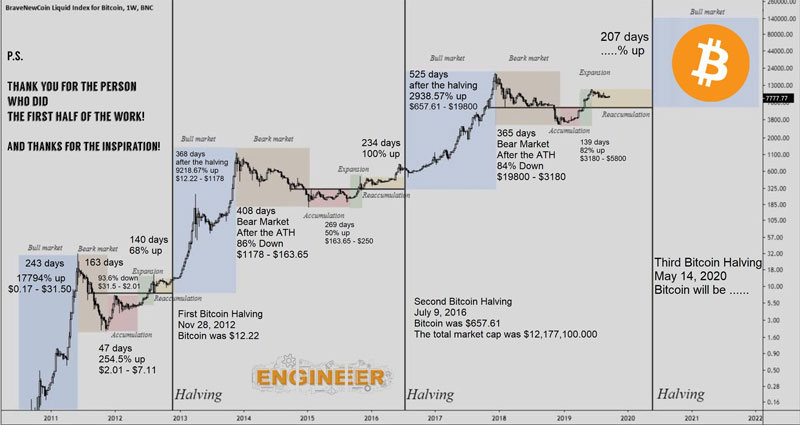Bitcoin Halving: 2020 BTC Mining Block Reward Chart History

Is the BTC Block Reward Halving Really a Bullish Factor?
The most popular crypto-centric question today is about the details of the infamous bitcoin mining halving.
Every four years, Bitcoin’s block reward (earned by miners who successfully add new blocks to the end of BTC’s blockchain) is cut in half. This is a day-one Satoshi whitepaper core component that has not nor will not deviate from the origins of bitcoin’s first release of turning CPU time and electricity into a digital currency.
The fascination lies within the actual bitcoin halving date not being set to occur on a specific day but rather once the written-in-code blockchain distributed ledger technology’s public chain of blocks gets to block height #630,000. At its foundational-base, every ten minute cycle continuously produces a new block (currently at 12.5 BTC / lowers to 6.25 BTC) as this magical phenomenon happens every 210,000 blocks.
First, a reduction from 50 BTC to 25 BTC in November 2012, then the second halving shifted the pre-determined goalposts from 25 to 12.5 BTC in July 2016. Now, the anticipation of the next halving event will see the block rewards drop from 12 to 6.25 BTC in May 2020. This permanent change in the mining rewards system for newly-minted bitcoins is Satoshi’s vision for designing a deflationary, digitally-scarce cryptoasset.
The excitement is now building up about what effects the halving will have on bitcoin’s price and the entire cryptocurrency market, knowing the 18th million BTC (85% of all) has already been issued to-date.
For reference, the 2024 bitcoin halving date (in May/June) will be whenever the blockchain reaches a block height number of 840,000, effectively lowering the block rewards generation from 6.25 BTC down to 3.125 BTC per 10 minute increment. With exactly 30 Bitcoin halving events remaining (all 21 million bitcoins in circulation by 2140) there’s under 300,000 blocks to mine before the next blockhalf; let’s review the history, the celebratory party events and all-intriguing price volatility fluctuations bound to happen.
Bitcoin Mining Halving Sentiment: The Bulls vs Bears

For the rest of 2019 and first half of 2020, bitcoiners anxiously await to see if the consensus comes true. In the words of Mr. Tepper regarding the 2016 bitcoin halving, Fitz said, “It’s Halvening!!!”
There is no shortage of #BTC hope and optimism (hopium) being tossed around into all kinds of bold outcomes about this major mining milestone. In traditional markets, a simple rule of thumb usually concludes if you reduce the overall supply of newly issued coins it will more than likely lead to higher price per coin. So far, history sides with bitcoin’s price seeing a substantial rise in the past due to increased demand overtime.
It may be commonly accepted in the crypto world that the block reward halvings are bullish for Bitcoin’s price due to the charts outlined below. Indeed, when you look at the price charts for the past two $BTC halvenings, this obviously appears true from a zoomed-out historical viewpoint. The November 28, 2012 halving the bitcoin price was $12.35 BTC/USD and 5 months later was $127 USD. The July, 9 2016 bitcoin halving day’s price was at $650 USD and was nearly $760 just five months later. The needle is moving once again.
The Bitcoin network software is built-upon a few invariable premises. At 12.5 BTC x 6 (six 10 minute cycles per hour) is 75 bitcoins minted per hour x 24 hours per day is 1,800 BTC per day issued. Then, quick math for 2020 halving and beyond to the next for years until 2024, shows it will be 6.25 BTC x 6 equals 37.5 per hour x 24 hours per day is only 900 BTC per day rewarded. This is a 50% reduction, effective instantly.
Further, simple math puts the past four years of block rewards mining system going from 1,800 per day, which is 657,000 BTC annually, to 900 BTC per day which is only 328,500 BTC annually in comparison. Sprinkle in some natural cryptocurrency adoption, regulation clarity and payment tech optimization and it is a recipe for a very entertaining 2020 pre and post bitcoin halving year.
It does not take an economic savant to apply simple supply and demand consensus mechanisms regarding scarcity of supply and rising demand. The debate about bitcoin being a possible safe haven asset shelter upon global turmoil and uncertainty is growing daily, weekly and monthly. Once the 2020 bitcoin mining halving happens, the on-chain effects are immediate and impact formulated forever. When these scales are tipped in the favor of lowering the newly created bitcoins granted for successfully mining a block and getting the reward to the miner trading computational power and securing the Bitcoin network, price volatility is bound to unfold.
Bitcoin Halving Charts: Historical Price Action Analysis
One caveat to consider is to know what can enhance the upward trend following the halving, like it has historically in the charts in 2012 and 2016. An acceptance as a reservoir can really build a strong foundation and bigger base. As the man (or women), or they, myth or legend Satoshi Nakamoto put it:
“It might make sense just to get some in case it catches on. If enough people think the same way, that becomes a self-fulfilling prophecy.”
Many want to know what will the price be at the date of halving. Here is a visual representation overview of the historical timeline.

The two previous price peaks have both occurred approximately one year after the halvings, suggesting perhaps the next peak will occur in mid-2021 if the pattern repeats. Will the third time be a crypto charm?

Before comparing the first 2012 halving to the 2016 bitcoin halving, the quote on controlled supply from Bernard Dempsey hits home:
A fixed money supply, or a supply altered only in accord with objective and calculable criteria, is a necessary condition to a meaningful just price of money.
As the era of decentralized finance emerges, here is what we know so far.
With roughly 360,000 blocks left to mine with nearly 200 days left before the official btc blockchain mining halving in the middle of May 2020, and factoring in what the 2012 all time high and low prices of $12 to $1,163 peaks (96x return) and falling back down to $220 range or the 2016 value of $658 USD and seeing nearly $20,000 all time highs (30x return) and falling back down to $3,100 range, many love to speculate about how the bitcoin halving will effect the BTC price in the new few months before and after the block rewards are cut in half for the third time in history.
Here are the flagship crypto cliffnotes about the past bitcoin mining block reward halvings:
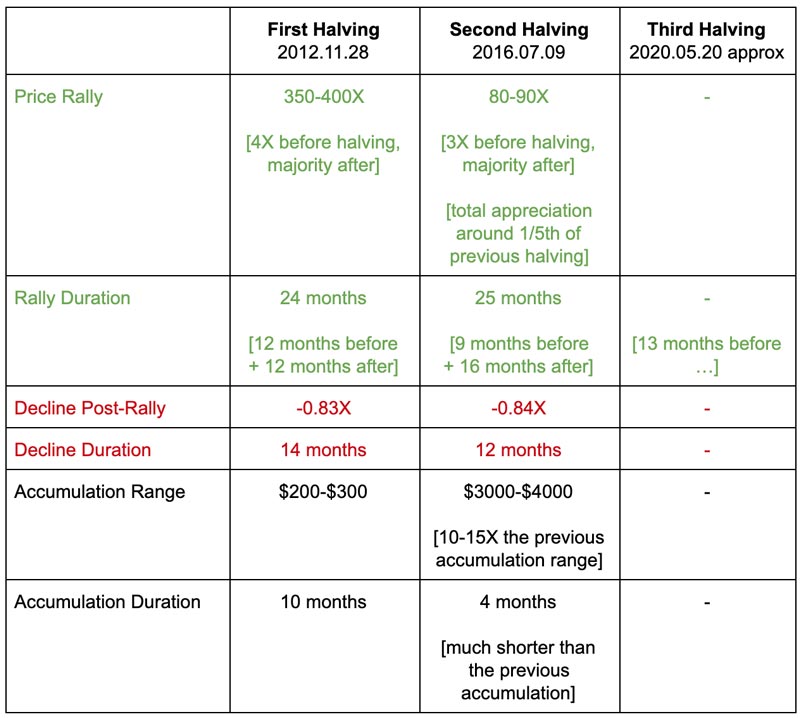
image courtesy of huddl
First Halving: took place on November 28, 2012 with a price of $12.50 BTC/USD exchange rate
Price Ranges: before halving it got boosted four-fold, then increased its value by 350-400X
$BTC Price Status: the first halving response lasted 1 year before and boosted valuations 1 year after
Post Bull Market Cycle: bitcoin declined in value by 83%, then accumulated at $200-$300 for 10 months
The summarizes into bitcoin bull market price action lasted a full 24 months, or two years long.
That is in the same timeframe we are in now gearing up for the third bitcoin mining halving event.
Second Halving: took place on July 9, 2016 with a price of $650 BTC/USD exchange rate
Price Ranges: the price of BTC went up three-fold before halving event before going up 90X
$BTC Price Status: accumulation started nearly 9 months before, appreciation in value lasted 16 months
Post Bull Market Cycle: declined the value of bitcoin by 84% before consolidating at $3,000-$3,500 base
The second halving symbolizes the bottom of bitcoin’s price to be 10X of the first halving support.
Third Halving: May 20, 2020
Price Ranges: April 1, 2019 bitcoin price went above $4,000 and saw as high as $13,400 in June
Bull Market Status: while the price of bitcoin hovers around the $8,000-$10,000 range, it’s wait and see
Post Bull Market Cycle: time will tell all, just grab the #whenlambo memes.gif and have the popcorn ready
However, the real question is whether the price action of the past has been caused by the block reward halvings, or if it was merely a coincidence. Most people in the cryptocurrency industry will suggest that the former is true, but the need for verification needs to be thought out in multiple ways. Nothing is guaranteed.
While the first mining halving cycle was referred to as the retail cycle, followed by a venture cycle, the third phase is dubbed the institutional cycle. That puts only 2.6 million blocks out of 21M total left. #digitalscarcity
But First, A Background Drop on the BTC Halvings
The first two bitcoin halvings saw extremely similar patterns surface as the stages transpired as such:
before: the anticipation of a significant reduction in the new block rewards and liquid supply boosts price
after: FOMO kicks in, higher demand comes in from retail speculators and fresh investors with deep pockets
crash: the bubble burst goes boom, a colossal collapse ensues after reaching all time high in BTC/USD values
the fall: demand goes down the drain, blood in the streets mentality, harsh realities of a crypto winter set in
foundation: a new base finally settles, market equilibrium restores itself and accumulation stage begins
One of the greatest features of Bitcoin is it’s capped supply of 21 million and it’s predictable inflation schedule, which is a native part of the Bitcoin code. In the chart below, you can see the existing supply of bitcoins vs. the rate at which 1,800 new coins are being mined (144 blocks per day x 12.5 BTC).

coinmetrics new bitcoin mined daily graphic
At first glance, the block halvings are certainly a disadvantage for those who mine Bitcoins. However, this is a crucial step to reduce currency inflation — bolstering Bitcoin’s main value proposition. And, so long as more people believe in that value proposition, the “real world” value of mining new blocks can keep increasing over time even as the block reward is halved. The next halving cycle will depreciate to 900 new coins daily.

If 1 BTC is worth $100k, a 6.25 BTC block reward would be worth significantly more to miners than a 12.5 BTC block reward when BTC is worth just $10k. On top of that, miners profit from transaction fees, which can become more and more valuable over time as the Bitcoin network continues to grow.
Reviewing the previous halvings
At the time of the first halving in November 2012, the entire Bitcoin economy was too small to be noticed by institutions. In fact, Bitcoin’s price had fallen by over 90% — from $ 31 to $ 2 — about 1 year prior. The price started to rebound in November 2011 and continued to rise through the halving in 2012 until it reached an all-time high of over $1200 in November 2013.
Of course, Bitcoin had another collapse that began at the end of 2013 and lasted until 2015. Then, about 8 months ahead of the next halving that would occur in July 2016, Bitcoin’s price started to recover. During this time, several venture capital companies and hedge funds became involved in the cryptocurrency market along with millions of new retail investors, ultimately pushing Bitcoin to a value of nearly $20k in December 2017. Again, ,ost of the appreciation came after the halving: BTC was worth $650 at the time of the halving, and subsequently increased by more than 30x.
Halvings and bull markets past

The brief review of these two cycles shows an obvious trend in which Bitcoin’s price starts to rise 8-12 months before a halving is anticipated to occur and continues for about 1 year following it. What needs to be investigated is whether the halvings are causing this positive price trend, or if the bull markets and halving events are merely correlated by coincidence.
Factors that affect Bitcoin’s price
Let’s analyze the factors that could provide us with explanations on how the halving leads to an increase in the value of Bitcoin. First of all, we need to analyze the activity of the miners.

blockchain.com graph showing the all time high rate power of the bitcoin blockchain
Bitcoin miners play a key role in the Bitcoin network by confirming transactions. However, miners are also considered marginal suppliers because it’s thought that they typically sell their newly mined bitcoins as soon as possible. All other factors being equal, if miners have fewer bitcoins to sell after a halving, they reduce the total sell volume (i.e. the supply side of the market). As we know, when supply decreases while demand stays constant, price increases.
Another component to consider is that Bitcoin miners have two sources of revenue: the newly minted bitcoins and the transaction fees. When all 21 million bitcoins have been mined, transaction fees will remain the only source of revenue. Even though transaction fees are taken from the existing supply of Bitcoin, for miners they are a source of revenue just like block rewards. In fact, miners are equally likely to sell them to cover their operating expenses. Therefore, the value of transaction fees must also be considered as part of the supply side.
Of course, the other side of the market is demand, which has increased significantly over time as retail, venture, and institutional money have all gotten involved. This growing demand has no doubt had a massive impact on price increases — further muddying the waters as to whether the halvings have been major causes of the past bull markets or if it’s just a coincidence that they occurred during times when demand was taking off.
Popular Theory: “Halving Reduces Liquid Supply Significantly”
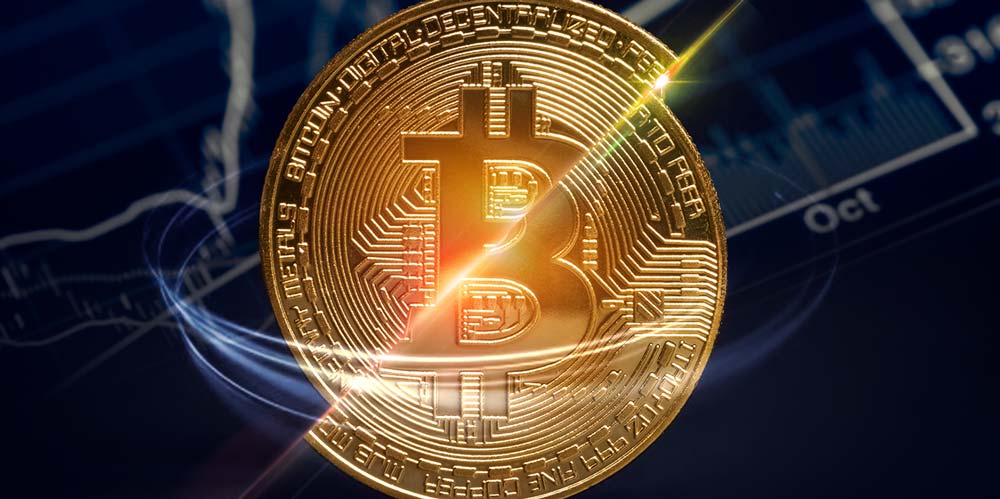
The “liquid supply” of a currency is the portion of the total supply which is actively circulating. In other words, HODLing your Bitcoin for months or years on end removes them from the liquid supply, because they aren’t being traded or exchanged.
It’s believed that miners aren’t typically HODLers because they have to sell into fiat currencies to pay operational expenses. This means that newly mined BTC are part of the liquid supply.
In the first ~4 years of Bitcoin’s existence, 7500-8000 BTC were mined every day and added to the circulating supply. After the first halving, this amount fell to 3700-4000. Currently, 1900–2000 Bitcoins are added to the supply every single day, which will drop below 1000 Bitcoins a day after the next halving.
In terms of US dollars, what emerges is a somewhat different view. As we mentioned, Bitcoin’s price was $13 on the day of the first halving. So when the daily amount mined was cut by about 4000 BTC (from 8000 to 4000), this amounted to a ~$52k reduction in value of Bitcoins joining the liquid supply each day. For the second halving when BTC was $650, this amounted to approximately $1.3M reduction.
But what does that mean?
Well, think about it this way: a reduction of any sizeable amount in liquid supply means that even if demand stagnated and remained flat, the price would increase as a result of the halving. This, ultimately, is why many people think that halvings are bullish.
Contradicting Theory: Efficient Market Hypothesis
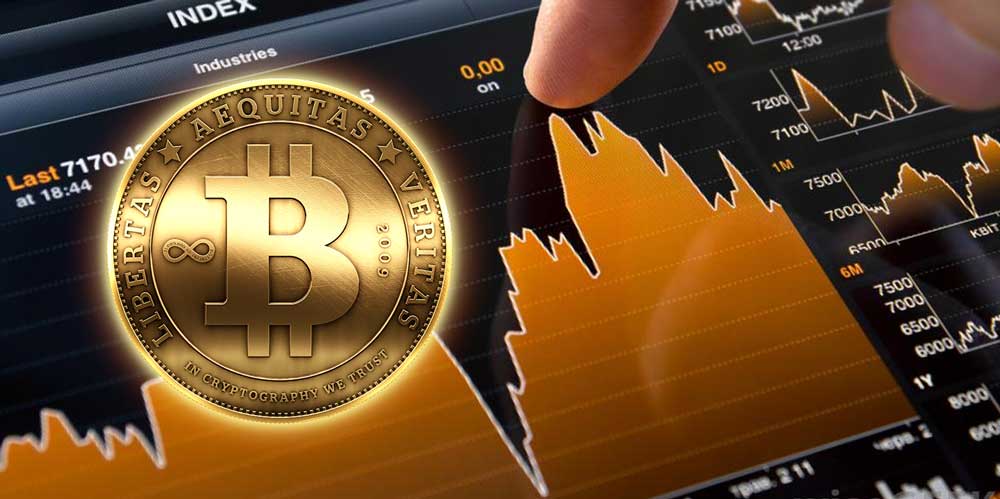
There is one HUGE point that the halving bulls tend to ignore or explain away: the efficient market hypothesis (EMH). This essentially states that in a rational market, assets always trade at their fair value on exchanges.
Of course, no market is perfectly rational. The question is: how rational is the Bitcoin market?
Bitcoin’s inflation schedule is known years in advance. That means that the reduction in liquid supply that results from a halving is known to every informed participant in the market years in advance.
If this is public knowledge, the EMH states that the effects of the halving should be priced in by the market before the halving actually occurs. In other words, it can explain some of the bullish price action that seems to occur in the months leading up to a halving, but the bullish price action afterwards wouldn’t be a result of the reduction in liquid supply if the EMH holds true.
With venture and institutional funds now holding heavy bags of Bitcoin, it seems likely that the market is far more rational today than ever before. So with that being said, how likely is it that the next halving will actually trigger another huge bull run?
If the Bitcoin market isn’t efficient, why didn’t hashrate drop after past halvings?
One final point to consider is the important metric of network hashrate. That is, the total computing power of all the miners in the Bitcoin network at the time of the halving.
If miners have to sell most or all of their coins immediately after receiving them to pay for their operational costs, you would expect the halvings to make mining unprofitable for many miners.
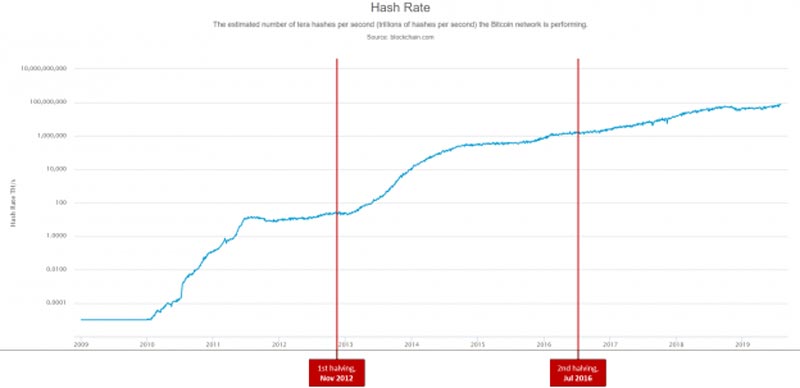
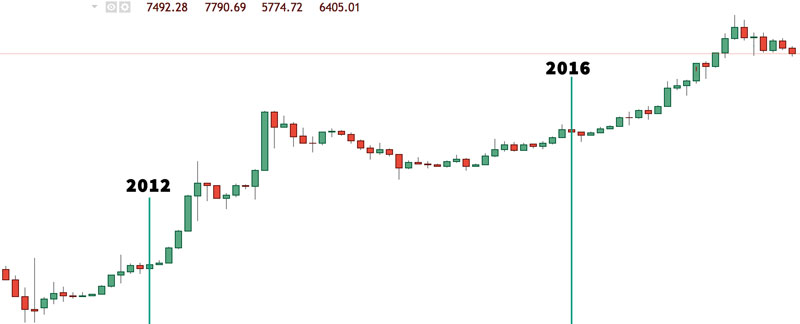
However, based on the historical hash rate, halvings have not caused any noteworthy drops in total hashing power. This indicates that perhaps the EMH is valid, and miners are rational enough to include halvings when they calculate future costs and revenue.
In a non-techy way, in the past it was easier to solve blocks and generate new bitcoins for miners. Lower competition, mining difficulty adjustments were smaller and less powerful hardware equipment (ASICs) to solve cryptographic algorithms was required than today. The new halving it will usher in a whole new era of the mining industry.
Conclusion: Causation or Coincidence?
Reflecting on the two contradictory theories above, one thing we can say is that the next halving is not guaranteed to cause another bull run to a new all-time high. It could just as easily be the case that the next halving makes mining unprofitable for a large portion of the current miners, leading to a shard drop in hashrate and decrease in public sentiment about the stability of the Bitcoin network.
Maybe Bitcoin’s market is efficient, and halvings do get priced in ahead of time. That would explain why price action has turned positive many months before each of the past halvings. At the same time, isn’t it possible that the months of positive price action leading up to the halvings garner significant attention from new investors, driving up demand and fueling the latter portion of the bull markets following the halvings?
It’s hard to say for sure now, but maybe we’ll have our answer after another halving or two. Many are in agreement that given the fixed-supply asset, a price appreciation will occur. This scarcity enhances value motto in the bitcoin world will have an even greater compelling tendency to be bullish going into the 2020 bitcoin halving event.
We’ll leave you with one last thought and a few questions…with the honorary wisdom of Satoshi Nakamoto, lets close out this bitcoin halving guide with a poignant message he/she/they sent to the early-adopting crypo community:
“If you don’t believe me or don’t get it, I don’t have time to try to convince you, sorry.”
Should investors take the bite and bet big on bitcoin and see these sub $8,000-$10,000 prices today as a one-time buying opportunity? As a smart investor, there is a market opportunity where the world is watching and can predict when the reduction of any commodity supply by 50% is going to happen. This is likely to have ripple effects felt all across the ethereal realm of virtual currencies and cryptoassets led by the number one crypto, Bitcoin.
Will the store of value element of bitcoin come into play and live up to its digital gold 2.0 nickname? What makes any object of interest valuable is the law of supply and demand. Can the leading cryptocurrency continue to outdo its all time highs and surpass old peaks? Time will tell, the question is whether or not you will be behind, before, or backing bitcoin’s halvening.
I’m Aziz, a seasoned cryptocurrency trader who’s really passionate about 2 things; #1) the awesome-revolutionary blockchain technology underlying crypto and #2) helping make bitcoin great ‘again’!
The post Bitcoin Halving: 2020 BTC Mining Block Reward Chart History appeared first on Master The Crypto.



